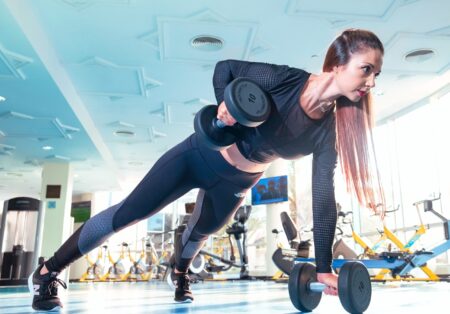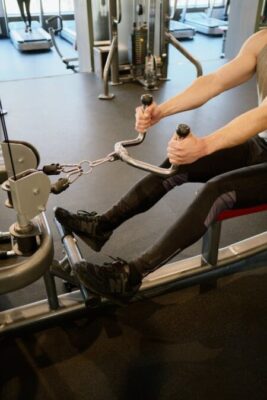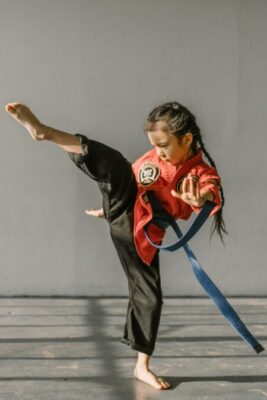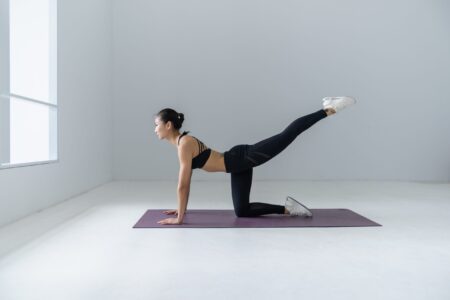Your Workout Dictates Your Garage Gym Flooring

Think about a professional gym—it has different flooring for each activity. You’ll find thick rubber under the weight machines and barbells for protection and shock absorption. The yoga studio features glossy wood for stability, while the martial arts area requires a specific blend of traction and cushioning.
None of these specialized surfaces are right for practicing soccer or baseball drills. The best garage gym flooring for you is the one that matches your specific activities.
For machines and heavy resistance training, rubber is the best garage gym flooring. It resists tears, provides superior shock absorption, and protects your concrete foundation.
For yoga, vinyl tile can offer a stable, non-cushioned surface similar to a studio’s wood floor, which helps promote better balance. For martial arts, vinyl-covered foam provides the ideal mix of cushioning for falls and a low-traction surface for pivots.
If your focus is on agility and field sports, artificial turf is the top choice for practicing your drills indoors.
Why You Shouldn’t Work Out on Bare Concrete

Working out directly on a concrete floor is not only bad for your joints but also potentially damaging to the concrete itself. This hard, unforgiving surface has zero give or shock absorption.
While some hardcore CrossFit studios might use bare concrete, most fitness experts agree that exercising on it increases the risk of stress on your joints. As noted by experts at Garage Gym Reviews, the unrelenting hardness can lead to joint problems over time.
Concrete is also very cold, especially in the winter months. It tends to hold moisture, creating a “wet cold” feeling when you lie down for floor exercises, making your workout less comfortable.
Finally, your concrete floor is not indestructible, even if it can hold a three-ton truck. If you drop a heavy barbell on it, you can easily crack, chip, or create divots in the surface, all of which will require patching later.
What Are the Best Flooring Types for a Garage Gym?

The best flooring to put over your concrete garage floor depends entirely on your workout style. Each material offers a unique combination of durability, cushioning, and traction to support your fitness goals.
Rubber is the best all-around choice for home gyms that include machines and barbells, offering unmatched durability and shock absorption.
Foam provides excellent cushioning for yoga and light exercises, but it isn’t durable enough to handle heavy equipment.
Vinyl offers a hard, easy-to-clean surface with good traction for specific activities like yoga and martial arts.
Artificial Turf is a purpose-built material for agility training and practicing field sports, effectively mimicking the feel of an outdoor lawn.
To help you choose the perfect material for your needs, detailed breakdowns from guides like this one at Gym-Flooring.com can offer further insight.
Should You Choose a Rubber Floor for Your Garage Gym?

Rubber is the undisputed champion for a garage gym focused on machines and heavy weightlifting. Its thick material gives you the cushioning you need to protect both yourself and the concrete underneath.
It is the most popular garage gym flooring for good reason. It’s soft, cushioned, and extremely durable, providing excellent shock absorption that muffles the sound of a dropped weight.
As long as the rubber is thick enough, heavy machines will not create permanent indentations. For general use with heavy machines, a thickness of at least 8mm is recommended.
If you plan on dropping heavy weights, like in deadlifts or Olympic lifts, experts suggest 12mm or thicker to fully absorb the shock. This prevents damage to your concrete foundation.
On the downside, some recycled rubber flooring has a distinct odor that can take time to fade. People with latex allergies should also check what the material is made of before purchasing.
According to flooring guides from Renuity Home, rubber does not stand up well to gasoline or solvents. This makes it a poor choice if you also park vehicles in the same space.
Is a Foam Floor the Right Fit for Your Workout?

Foam interlocking tiles are an excellent choice for yoga, stretching, and general floor exercises. They provide support and traction similar to rubber but usually at a lower cost and with more cushioning.
Foam offers the softness of rubber at a more accessible price point. It absorbs the impact of light weights well and is very comfortable for any floor work.
However, foam is not very durable and has some significant drawbacks. It can tear or puncture easily if you drag equipment across it or drop something sharp.
Placing heavy machines on foam can also cause permanent indentations, ruining the surface. Foam also has high traction, which makes it less than ideal for martial arts, and it’s not durable enough for field sport training.
What About Vinyl-Covered Foam for Martial Arts?

For martial arts, vinyl-covered foam is the best over-concrete flooring choice. This hybrid flooring gives you the benefits of both materials for combat sports and general fitness.
The foam base provides a supportive cushion for falls and takedowns. Meanwhile, the smooth vinyl surface protects the foam from tears and reduces traction for safer pivots and footwork.
Standard foam and rubber have too much grip for the movements common in martial arts, which can lead to potential joint injury. The vinyl top layer allows for fluid movement while reducing skin burn.
A vinyl-covered foam tile is fully encased in a protective vinyl sleeve, while a vinyl-bonded tile has a vinyl layer fused to the top of a foam base. Both options have much less traction than plain rubber or foam.
While this slipperiness is a major advantage for martial arts, it can be a disadvantage for some exercises. However, machines perform well on this surface, and it’s a comfortable choice for yoga.
When Is a Vinyl Garage Gym Floor a Good Idea?

When considering vinyl, it’s crucial to distinguish between durable interlocking vinyl tiles and thin sheet vinyl. Vinyl tiles are a good garage gym flooring choice; sheet vinyl is not and should be avoided.
The tiles lock together to form a sturdy, water-resistant surface that holds up to machines and dropped weights. Vinyl also has less grip than rubber or foam, making it a good surface for yoga and martial arts where stability is key.
Many prefer vinyl tile because it copies the hard, stable feel of a glossy wooden studio floor. As with a yoga studio floor, vinyl is slippery with socks but offers good grip with bare feet, enhancing balance.
The main drawback is that it offers very little shock absorption. As flooring comparisons show, while the tile won’t break from a dropped weight, the impact energy will transfer directly to the concrete underneath, potentially causing damage.
Can You Use Carpet for a Garage Gym Floor?

Carpet tiles, specifically those designed for high-traffic areas, can be a viable option for a multi-purpose garage. They offer some cushioning and will protect the concrete from most impacts.
A key benefit of carpet is the warmth it provides, making the garage a more inviting workout space, especially during colder months. It can create a comfortable environment for light activities.
However, carpet has significant downsides for a dedicated gym space. Its high traction can cause rug burns during floor exercises or martial arts training, making these activities uncomfortable.
More importantly, carpet traps dust, dirt, and allergens, which get kicked into the air during a workout, affecting air quality. While it’s better than bare concrete, carpet is generally not an ideal gym floor.
Artificial Turf is the best over-concrete flooring for agility drills and practicing field sports. It is designed to replicate the traction and drag of an outdoor lawn, making it ideal for pushing sleds, footwork drills, and plyometrics.
Its texture and traction mimic a real grass field, making it perfect for sports like soccer or baseball. However, be aware that the high traction creates a risk of skin burn, similar to a grass burn outside.
The lack of cushioning makes it similar to carpet for heavy machines or dropped weights. While a turf floor will likely survive a dropped barbell, the concrete underneath may not fare as well.
Artificial turf is not cushioned enough for martial arts. While heavy machines won’t dent it, the surface doesn’t add any performance benefit for weightlifting compared to rubber.
How Thick Should Your Garage Gym Flooring Be?

The right thickness depends on your flooring material and planned activities. In general, thicker flooring provides more cushioning, warmth, and sound dampening for a better workout experience.
For rubber flooring, a thickness of 8mm (or about 3/8 inch) is recommended for areas with heavy gym equipment. This provides a solid base of protection for most uses.
If you’re into serious weightlifting and might drop heavy weights, you should opt for 12mm thickness or more for maximum protection against cracking your concrete.
For foam tiles used for yoga, stretching, or bodyweight exercises, look for a thickness of 20mm or more. As recommended by home gym experts, this thickness provides adequate cushioning for floor work.
Remember to avoid placing very heavy equipment on foam, regardless of its thickness, as it can cause permanent indentations.
Which Material is Right for You? A Quick Comparison

Understanding the key differences in flooring materials can simplify your choice. Consider how each performs in terms of moisture resistance, shock absorption, and durability.
Rubber and vinyl both offer excellent resistance to sweat and oils. This makes them easy to clean and maintain in a high-use gym environment.
For the best shock absorption, rubber, foam, and carpet are superior. They provide more cushion than the harder surfaces of vinyl and artificial turf, which is crucial for protecting your joints.
Foam offers cushioning similar to rubber but at a lower cost and without latex. However, it tears much more easily and is not suitable for supporting heavy weights or equipment.
Ultimately, your decision comes down to balancing these features with your specific workout needs and budget.
Ready to Build Your Perfect Garage Gym Floor?

Choosing the right garage gym flooring is more than just a practical decision; it’s the foundation of your new fitness space. The right surface protects your body, your equipment, and your home.
By matching the material to your unique workout style—whether it’s heavy lifting, agile footwork, or mindful yoga—you create a safer and more effective environment. This simple upgrade can inspire you to work out more consistently and with greater intensity.
Don’t let a hard, cold concrete floor hold you back any longer. Invest in the right flooring today and take the first crucial step in building the personal gym you’ve always wanted.
Ready to Build Your Perfect Garage Gym Floor?

Choosing the right garage gym flooring is more than just a practical decision; it’s the foundation of your new fitness space. The right surface protects your body, your equipment, and your home.
By matching the material to your unique workout style—whether it’s heavy lifting, agile footwork, or mindful yoga—you create a safer and more effective environment. This simple upgrade can inspire you to work out more consistently and with greater intensity.
Don’t let a hard, cold concrete floor hold you back any longer. Invest in the right flooring today and take the first crucial step in building the personal gym you’ve always wanted.










